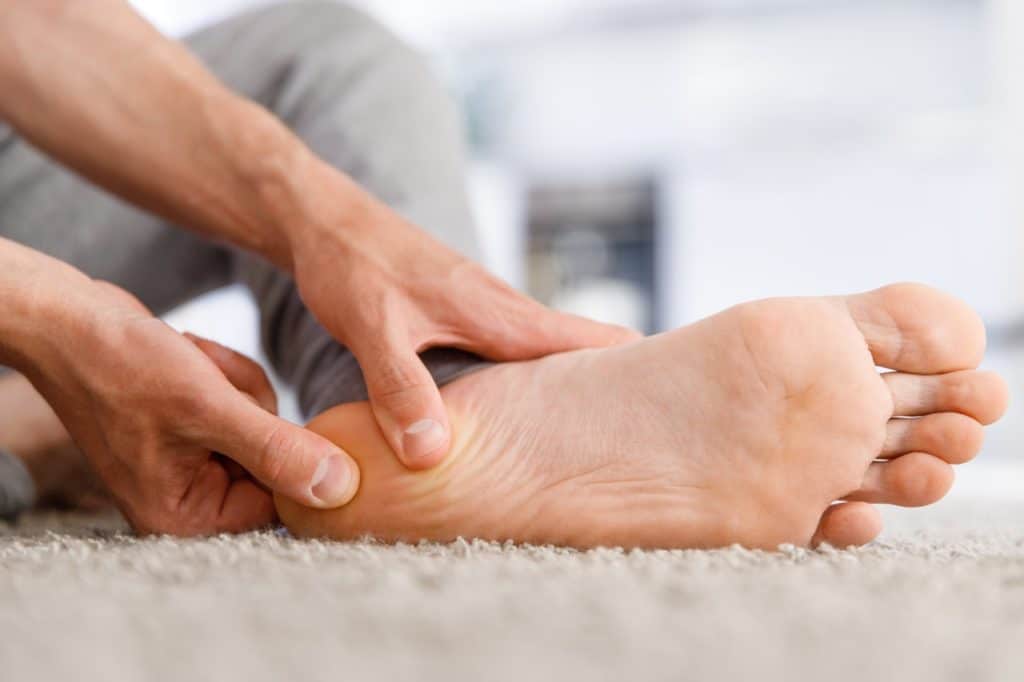Heel pain can be very debilitating, and plantar fasciitis is the medical name. It can keep you from participating in many activities that you enjoy and make everyday tasks more difficult. Heel pain is caused by a variety of things, including plantar fasciitis, heel spurs, and Achilles tendonitis. While heel pain may seem like a minor inconvenience, it can have a significant impact on your quality of life.
This type of heel pain is often referred to as ‘Policeman’s Heel’. This name is derived from the fact that the condition was once commonly seen in police officers who worked long hours on their feet. It often starts as an intense pain, where the patient cannot put their heel down, resulting in them walking by putting weight on the toes.
Understanding plantar fasciitis
What is plantar fasciitis, and what causes it?
There are 26 different bones in your feet that are held together by a complex of muscles or tendons with ligaments. The plantar fascia is the main structure on the bottom of your foot that supports and maintains the arch and runs from your heel to your toes. If the plantar fascia becomes overworked and damaged, it may fail to support the arch leading to various degrees of collapse. If the arch collapses further stretching of the muscle leads to intense pain where it attaches to the heel bone. Therefore, when weight is put on the heel, intense pain can also be felt on the inside arch of the foot.
Risk factors and symptoms of plantar fasciitis
Is heel pain beginning to ruin your life?
Heel pain and arch pain can become very debilitating, making it difficult to do many everyday tasks. From the first steps in the morning and throughout the day plantar fasciitis can ruin all daily activity
- Pain from getting up in the morning
- Pain walking to the car or train, during a work commute
- Standing up following a period seated – office, dining or watching TV
- Pain halfway through a round of golf and having to stop
- Pain during shopping and having to come home sooner
- Pain when walking the dog, taking much shorter length walks
- Pain at work when getting up from the desk after a period of sitting
- Pain during exercises such as jogging or running
Diagnosing and treating plantar fasciitis
How is plantar fasciitis diagnosed?
Correct diagnosis is essential. Always seek expert advice to ensure a specific treatment plan is developed. This is where the Bachelor of Science degree level biomechanical expertise of the Podiatry profession can diagnose and resolve your heel pain.
To summarise, follow these important steps to reducing your heel pain:
- Get the correct assessment/diagnosis as soon as possible
- Engage in a specific treatment plan to your personal needs
- A long-term solution should be provided – such as Orthotic Insoles for your shoes
Engaging with foot specialists like Waverley Foot Clinic, which is run by a Chartered Physiotherapist with a special interest in biomechanics and orthotics, will help you get back to normal and living a pain-free life as soon as possible.
Here at Waverley Clinic Farnham in Surrey, we offer an extensive range of foot pain treatments, including plantar fasciitis heel pain assessment leading to your specific treatment plan:-
- Biomechanical Assessment to confirm the diagnosis – this will help to rule out any other potential causes of heel pain.
- Digital GaitScan to access the level of arch collapse/arch support required.
- If the arch has some capacity / moderate problem – stretching the Plantar Fascia may help, we recommend using using a PediRoller.
- The problem is usually linked to tight calf muscles, which must also be stretched. A specific demonstration, including printed instructions, will be provided.
- Another treatment method involves strapping the foot and ankle with tape. This can be helpful during the acute stage but cannot be used indefinitely.
- If there is substantial arch collapse – support will be required from orthotic arch support
- Shock Wave therapy or Laser Therapy can be helpful in repairing Plantar Fascia damage.
- However, sometimes, long-term arch support is an effective solution. Only when the arch structure is supported by an orthotic insole can long-term pain be resolved. The return of plantar fasciitis heel pain is almost guaranteed.
- Custom orthotics are created from the 3D foot shape image created during the GaitScan. Therefore, the orthotic insoles are both effective and comfortable.
- Our orthotic insoles have a large design range to ensure the correct fitting into your shoe choice and activity. So please bring a selection of shoes to an assessment appointment. There’s no point if you can’t easily fit them into your shoes!
- Sometimes, similar symptoms occur in the other foot. Therefore, treating both feet is advised to reduce the risk of pain in the otter foot at a later date.
Final thoughts: book a biomechanical assessment today at Waverley Clinic
In conclusion, seeking professional heel pain assessment, diagnosis and treatment is the best option to resolve plantar fasciitis heel pain fully. Waverley Clinic in Farnham has been treating such conditions successfully for over thirteen years.
Please call the clinic on 01252 716611 to use our 24/7 booking service, and remember to ask for a Biomechanical Assessment.
Alternatively, call the Waverley Clinic to discuss your issues or questions with our lead Podiatrist Jonathan Kirk.

